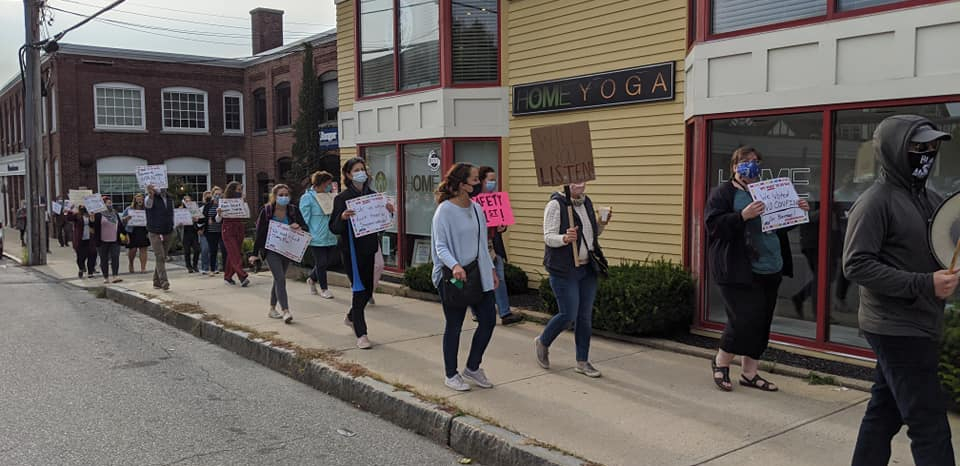Collective Action Is How We Shake Ourselves Free of Pandemic Isolation

Teachers in Andover, Massachusetts, marched on September 22 for a safe return to school memorandum of agreement. Photo: Andover Education Association
The pandemic has made me see more clearly why it works when workers get together to solve problems collectively.
With no public health system to access and a disorganized, inept, and neglectful response from the government, individuals have been cast out alone to deal with the pandemic. Decisions about working—and risking one’s health and safety—have become individual.
Workers at home are isolated and workers at worksites are afraid.
REINFORCED ALONENESS
I’ve watched as school employees and parents have been divided when given the choice to return to buildings, work remotely, or do a mishmash of both.
School districts have surveyed parents and educators, asking what individuals wanted for themselves. Unions that simply let members fill out their surveys alone reinforced the message: you are on your own, do what is best for you.
Which is why the contrast when workers come together to talk is so pronounced and powerful right now.
In Andover, Massachusetts, educators were told they’d be teaching with a hybrid model (some students in schools, some remote). Educators would have to work inside school buildings even when their students were offsite.
This included coming to the buildings before school opened for days of “professional development”—even though the instruction would be remote.
Outraged by this power play from the superintendent, union members met in their largest general meeting ever (virtually), debated, and voted to go to work on the first day of professional development—but to work outside of the buildings, in the parking lots and on grass fields next to the schools.
Union leaders were worried that even though members had voted for this action, not enough would follow through and the action would be a failure. So they called another meeting and recommended to vote no on a second vote.

SUPPORT LABOR NOTES
BECOME A MONTHLY DONOR
Give $10 a month or more and get our "Fight the Boss, Build the Union" T-shirt.
The members talked, debated, and voted once more to hold their action. On the day, even members who had voted no showed up with lawn chairs and laptops. They brought a generator and ordered port-a-johns.
Something had happened in those meetings that transformed members. They discovered each other as something more than the district or the union leadership thought them to be—and more than they previously knew themselves to be.
RADICAL RESPECT
We often say that the one-to-one conversation is the building block of organizing. Talk to members. Find out what they care about. Let them know they can do something to solve the problem. Make the ask.
We sometimes can treat those one-to-ones as simply that—one person talking to one person. But the key to unionism that can profoundly transform individuals and their worksites is members coming together in numbers to solve problems together, to make plans together and take collective action.
I’m not talking about a meeting that is really a dramatized memo, where information is dispensed and Robert’s Rules are enforced over votes for resolutions that are barely debated. I am talking about workers coming together in spaces of radical respect to know themselves as the ones who determine what their workday will look like.
In that sort of meeting, we see our shared interests, discover our shared wisdom, and grow courage through shared action.
We shake ourselves free from a sense of being beaten by waves of inevitable misery, and we see how we can change the structures that create those waves.
In Andover, management got the state to declare the outdoor workday an illegal strike. But that has not stopped the organizing.
These educators knew they were building power and were undaunted when the district tried to crush it. They met again, passed resolutions in support of the targeted president and vice president, and planned their next move.



